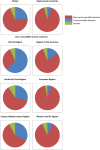Women's health: a new global agenda
- PMID: 28588958
- PMCID: PMC5321350
- DOI: 10.1136/bmjgh-2016-000080
Women's health: a new global agenda
Abstract
Global efforts to improve the health of women largely focus on improving sexual and reproductive health. However, the global burden of disease has changed significantly over the past decades. Currently, the greatest burden of death and disability among women is attributable to non-communicable diseases (NCDs), most notably cardiovascular diseases, cancers, respiratory diseases, diabetes, dementia, depression and musculoskeletal disorders. Hence, to improve the health of women most efficiently, adequate resources need to be allocated to the prevention, management and treatment of NCDs in women. Such an approach could reduce the burden of NCDs among women and also has the potential to improve women's sexual and reproductive health, which commonly shares similar behavioural, biological, social and cultural risk factors. Historically, most medical research was conducted in men and the findings from such studies were assumed to be equally applicable to women. Sex differences and gender disparities in health and disease have therefore long been unknown and/or ignored. Since the number of women in studies is increasing, evidence for clinically meaningful differences between men and women across all areas of health and disease has emerged. Systematic evaluation of such differences between men and women could improve the understanding of diseases, as well as inform health practitioners and policymakers in optimising preventive strategies to reduce the global burden of disease more efficiently in women and men.
Keywords: Health policies and all other topics.
Conflict of interest statement
Competing interests: None declared.
Figures



References
-
- World Health Organization. Health in 2015: from MDGs to SDGs. 2015. http://apps.who.int/iris/bitstream/10665/200009/1/9789241565110_eng.pdf?... (accessed 22 Apr 2016).
-
- World Health Organization. Global Health Estimates 2014 Summary Tables. 2014. http://www.who.int/healthinfo/global_burden_disease/estimates/en/index1.... (accessed 22 Apr 2016).
-
- Institute for Health Metrics and Evaluation. The Global Burden of Disease. 2013. http://vizhub.healthdata.org/gbd-compare/# (accessed 18 Aug 2016).
-
- Secretary-General UN. Global strategy for women's and children's health. New York: The Partnership for Maternal, Newborn and Child Health, 2010.
LinkOut - more resources
Full Text Sources
Other Literature Sources
Miscellaneous
